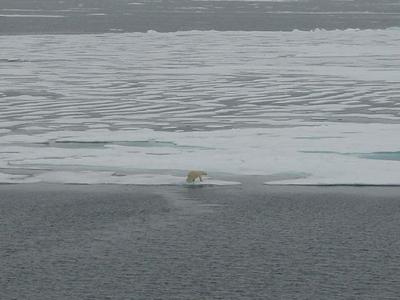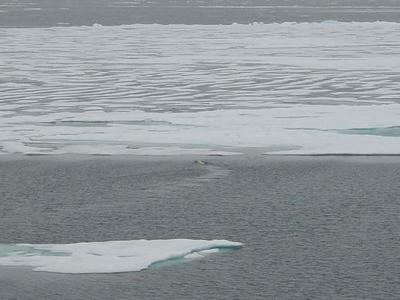
|
|
13 July, 2003
I have always thought of the Arctic as being the end of civilization.
Indeed, this clean, icy world of fresh air and clear water
contributes to an immense feeling of remoteness far from anything to
do with humanity. And at first glance, the two Polar Bears that we
observed this afternoon would seem to confirm this.
That's right, the great white Ursus maritimus! Although the two
bears were a considerable distance away from the ship, they still
provided quite a show for the large audience that gathered on the
Palmer’s bridge to see them. Earlier in the day, we had noticed
several Ringed Seals lounging by their holes in the ice, and
speculated that where there were seals there must be bears;
therefore, it was no surprise when Leopoldo Llinas, a graduate
student interested in zooplankton as well as bears, knocked on my
cabin door to tell me about the bears. (Several of us have an
agreement to wake-up or inform each other of unusual wildlife
sightings.)
They are not easy to see. Polar bear fur, like the ice, is
translucent. Usually it is easier to spot the bears' tracks than the
bear itself. Fortunately, this time of year at least, their fur has
a slightly yellowish color (from algae?) that helps me to
quickly find one of the bears in the surrounding white frozen
seascape.
However, as I enjoy watching the bears with everyone else, I am
reminded of some disturbing news that I recently learned about polar
bears before our cruise. The trouble involves human-made pollutants
that some scientists suspect may threaten the bears’ very survival.
In one study for example, polar bears near Svalbard, Norway were
found to have high doses of some industrial chemicals such as PCBs
(polychlorinated biphenyl compounds). And research in Barrow, Alaska
has detected high levels of mercury spread throughout the food chain
reaching all the way up to the Arctic's top predator, the Polar Bear.
The pollution seems to be transported by the wind or ocean where it
is concentrated by plankton, and then consumed by fish and marine
mammals such as seals, and ultimately, bears.
What this means for bears is not yet known, but there are some
disturbing signs beginning to be linked to high concentrations of
pollutants. Denning mother bears that lost their cubs were found to
have levels of PCBs three times higher than mothers whose cubs
survived. PCBs also seem to reduce the bears' immunity to disease by
suppressing their ability to produce antibodies. Certain pollutants
seem to be altering the levels of hormones in both male and female
bears and scientists are trying to determine if this affects their
fertility. In fact, in the Svalbard population of bears, 3 or 4
bears out of a hundred, exhibit genital abnormalities. And PCBs seem
to deplete the bears' reserves of vitamin A, which is essential for
regulating growth. Of course, much work remains to be done, but it
seems that the top of the world isn't as clear as it seems.
I guess we're not that far from the rest of the world after all.

Eric's shot of the bear up on the ice.

Eric Hutt's photo of a swimming polar bear.

Bear watching from the Palmer's bridge.
Contact the TEA in the field at
.
If you cannot connect through your browser, copy the
TEA's e-mail address in the "To:" line of
your favorite e-mail package.
|
